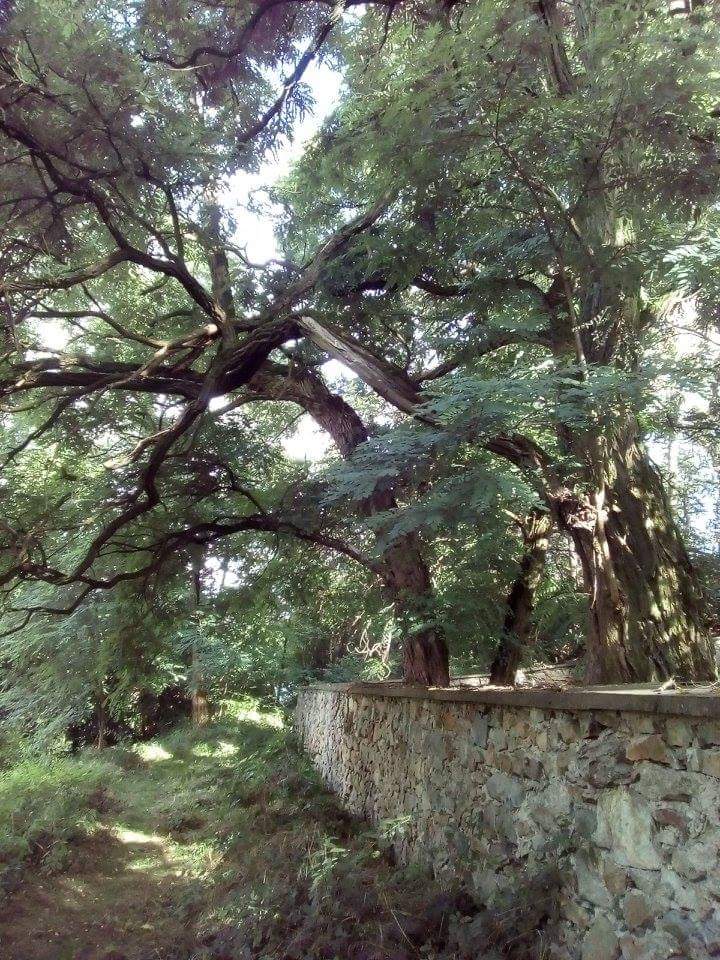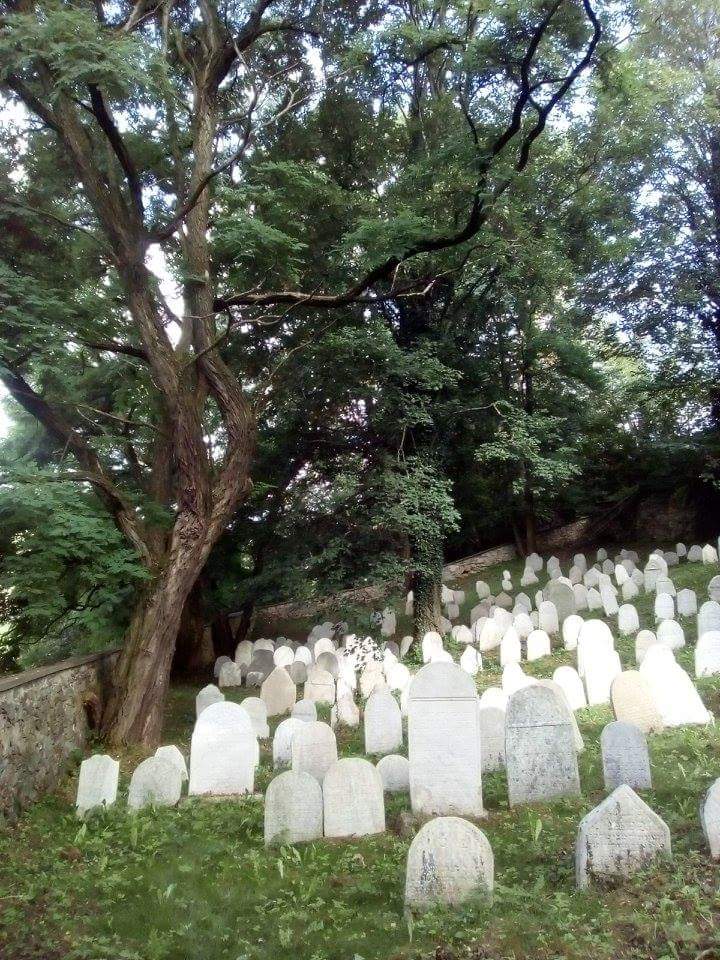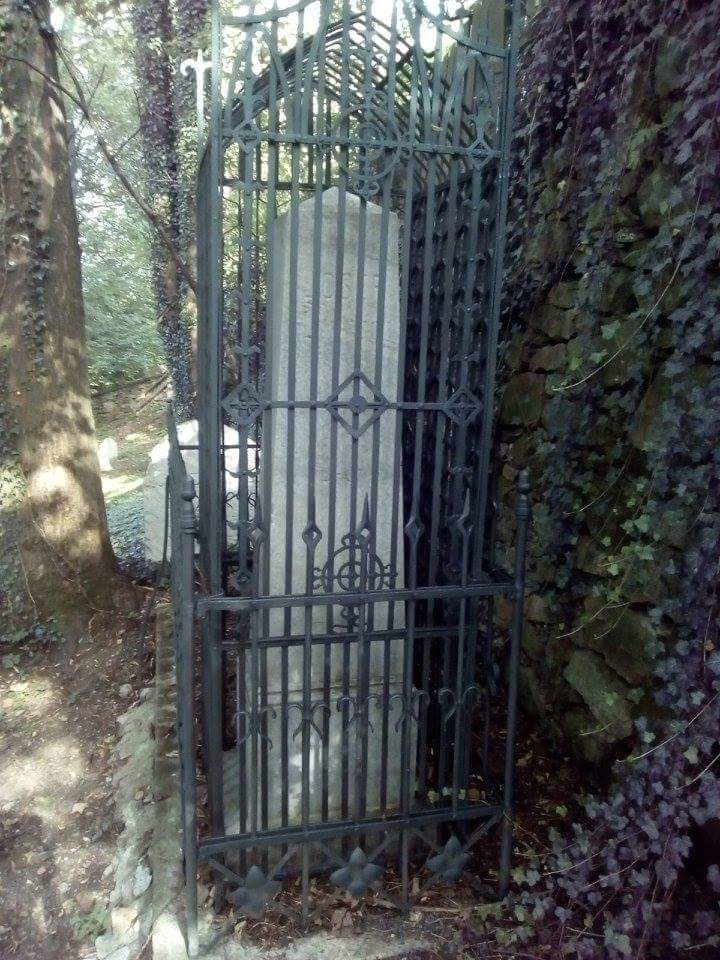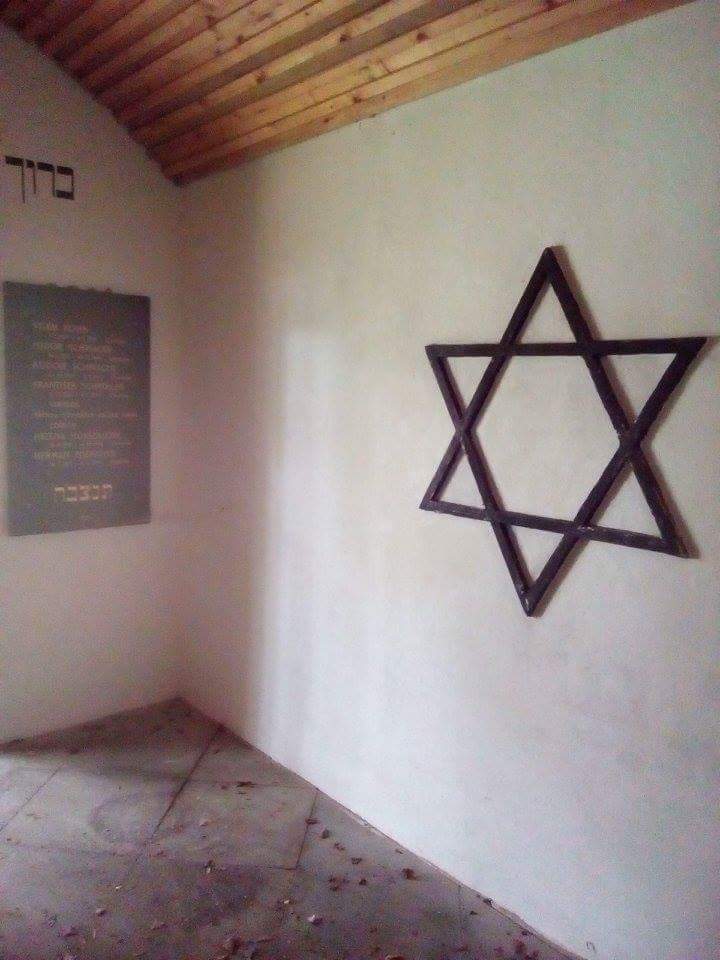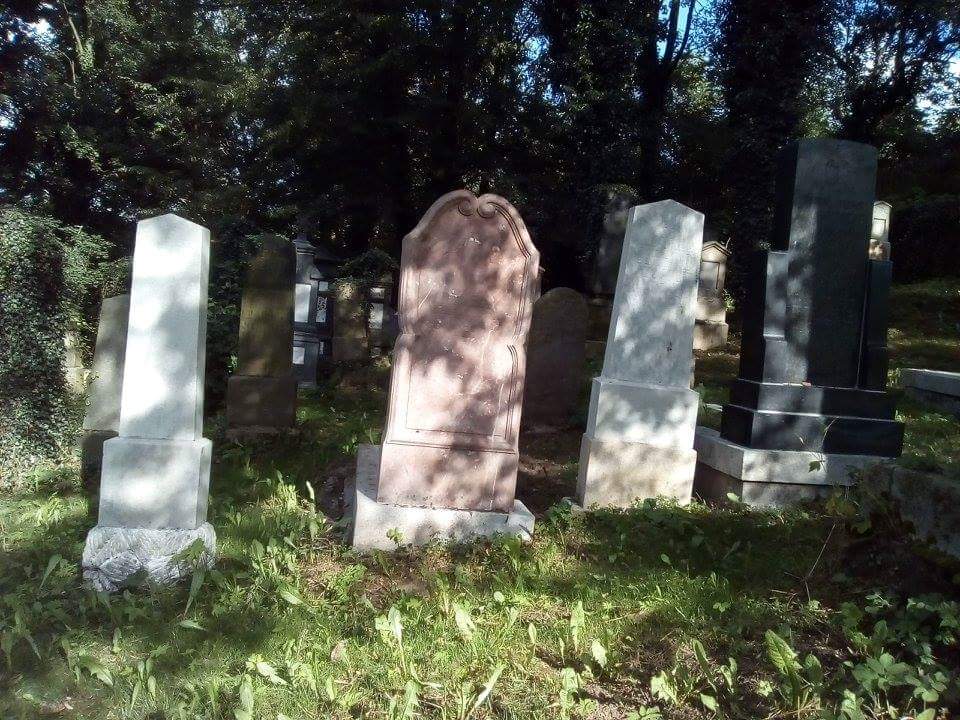Alternate names: Čkyně [Cz], Kieselhof [Ger], Čkyn, Tschkyn, Tschkyn . 49°07' N, 13°50' E, 48 miles SSE of Plzeň (Pilsen). 1930 Jewish population: 11. Chartered in 1537. The earliest known Jewish community in this town was 17th century, (1724 census). A small Jewish community (about 10 families) existed in the 18th century growing to 40 families (140-240 persons) in the 19th century. As population moved to larger cities, the congregation moved from Ckyne to Vimperk. Only 3 Jewish families (11 persons) lived in Ckyne in 1930. The present town population is 1,000 - 5,000 with none Jews. Jewish and cemetery history with photos.
KehilaLink [Oct 2013]
website in Czech with photo: "The cemetery 350 meters SE of the town, over the railway tracks from Strakonice to Vimperk. Established probably in the last quarter of the 17th century and extended in the 19th century, the landmarked cemetery has over 400 graves from 1688 to 1942, among them baroque tombstones of the south Bohemian with floral motifs. In the restored morgue from the 19th Century is a Holocasut plaque. During the 1990s, the cemetery was cleared of the vegetation and restoration of the mortuary enclosure wall. Fallen tombstones were righted. Currently ongoing maintenance cemetery continues with further restoration required. Between 2008 and 2009 valuable tombstones were threated by felled trees. In 2007 the restoration of dozens of historic tombstones began on epitaphs damaged. That work needs to continue in the future." [September 2011]
The synagogue in Ckyne (1828) is owned by the Society of Friends of Israel. Photo of grill protecting gravestone next to cemetery wall. Source. Burial list and genealogical resources from AustriaCzech SIG Jewish history. An annual [?] festival of Jewish culture and history called Jewish Days (www.zidovskedny.cz) was held in several locations in the Práchensko Region (Ckyne, Strakonice, Volyne, Písek) from July 17 until Sept. 23, 2007. The programme includes theatre and musical events, film screenings, lectures and literary evenings. A trip around the Jewish sites of the Práchensko region was planned.[February 2009]
A Jewish history of the towns in Prachatice District: In the Prachatice district are three preserved Jewish cemeteries: Those in Čkyně and in Vlachovo Březí were repaired in 1980s and 1990s, the one in Dub still under repair. Also, 96 Jewish victims of the Nazis had a kosher burial in Volary. The beginning of the Jewish settlement in Čkyně dates from the 16th century when, under feudalism, Jews had no rights regarding residence. Their life was conditional on the whim of ruler, feudal nobles, church, the Christian population, and political circumstances. The small town Čkyně was a trade and market center of SE Volyně district in late 16th century where several Jewish families already lived. Only one family survived the Thirty´s War according to the Roll of Assesment of 1654: "two Jews on the Vysoký dvůr in Čkyně: Šťastný and Izák". In the years 1703 to 1728 the owner of Čkyně, Adam František Hrušovský z Hrušova, defended "his" Jews against the Volyně council. Theresian land-registry from the year 1748 indicates ten Jewish families, six of them dealt in wool, linen and feathers, two families in skin, one family in spirit and one Jew worked as a painter.August 16, 1825 administrator of authorities listed 151 Jews and 526 Christians. 34 jewish families (207 persons) in1840. After 1849, when the legislative segregation of Jewish population in Austria ended, moving of Jews to bigger towns started. In 1890, the synagogue in Čkyně was closed, 11 Jews lived there in 1930. From the Čkyně Jews comes a significant Czech lawyer professor, Alois Zucker, (1842-1906): Czech Univerzity in Prague, author of scientific work, dean of the Czech Lawyer Faculty,representative of the Reich Council in Vienna (1885-1901), and member of the Royal Czech Company of Theory and of the Czech Academy. The first postman in Čkyně was Josef Lederer (died in 1905, buried in the local jewish cemetery). In the Prachatice district were four synagogues that even before the Holocaust stopped funtioning: Čkyně, Vlachovo Březí and Dub before 1920 for lack of members. Those synagogues were sold to private buyers, who rebuilt them as residential buildings. The synagogue in Vimperk, built by the Vimperk Jewish Community in 1925 and consecrated on January 3, 1926, was torched on November 10, 1938 by the Nazis. Only the Čkyně synagogue has renovated so far. The synagogue (No. 105) stands not far from the center of the town toward the railway station and is the second one there. Jewish settlement dated from the late 16th century so the old synagogue stood within the former manor, so called "Vysoký dvůr", next to the out-buildings of the manormaybe from the 18th century. After 1827, the then owner of the Čkyně demesne (the doctor of law JUDr. Karel Claudi) settled with local jewish community to take over the building and replaced it with the new synagogue at his own expense in1828. All buildings of the former manor were pulled down in the mid-20th century for the local Standard Farming Cooperative and later blocks of flats. In the Memorial Book of the Čkyně Parochial Office (kept from 1786 in the parish ) in Latin the construction and opening of the new synagogue are described by church administrator František Stáně. The construction of the buildingbegan on April 14, 1828 and on September 26 was finished, one of the biggest and most beautiful synagogues of former "Prácheňský" district. Later the winter prayer room with heat was added to the new building on the west sideon the first floor and below the sanctuary. Other rooms on the ground floor served originally as a Jewish school and rabbi's quarters. Research of Dr. Jan Muk from Prague and reconstruction architect František Petrlík from České Budějovice confirmed that. In 19th centuryí, the Čkyně Jewish community had a rabbi and cantor. Besides local Jews, those from the surroundings area were members. Regular services were held until 1895, then they were transfered to Vimperk, but rabbis still lived in Čkyně [after 1890, Jiří Bohumil Stranský, Mojžíš Reitler (1897) and Josef Bloch (from 1903).] For occasional services the synagogue served until the end of the WWI, under Rabbi Julius Löwenbein in Vimperk, the new seat of the Jewish community. The Čkyně Jewish Community was abolished in 1890 with only 3 Jewish families (11 persons) remaining in Ckyne, while 20 Jewish families (60 persons) lived in Vimperk (including Boubská village).In 1922, the Vimperk Jewish Community sold the former Čkyně synagogue (using the proceeds for new Vimperk synagogue construction) to the Španingers, who then adapted the building for a family house and workshop. To the east part of the synagogue, where the main prayer room was the ground floor was a cabinet-maker´s workshop and the first floor residential. The west part of the synagogue with the winter prayer room has been preserved unchanged as a residence until1983. Other synagogues that survived the Crystal Night 1938, were mostly pulled down during the communism or rebuilt for other purposes. After the German occupation of Bohemia and Moravia, a few Jews from Vimperk found asylum in Čkyně, but with the Norimberk Race Rules, the Jewish population was deprived of civil and human rights, excluded from political, economic, cultural life, and property confiscated. Deportations to the camps in November 1942, mostly via Klatovy to Terezin, followed, with death was waiting for the great majority, 650 prisoners to Terezín on November 26, 1942 and Ce with 619 prisoners to Terezín on November 30, 1942. Both transports totalled 1,196 people dead and 72 were saved (1 prisoner was not included). 14 of 16 Čkyně citizens of Jewish origin died: 2 women in Terezín, 7 men and 5 women in Osvětim. 2 local stayed alive thanks to their mixed marriages (Karolina Španingerová and Jaroslav Lederer, now deceased). Dead also were the sister of Karolina Španingerová, Julie Červinková, and former Vimperk trader Isidor Schwager and his sons Rudolf and František. For all the victims from Čkyně and surroundings, the ceremonial hall is dedicated in the local Jewish cemetery, where their names are hewn into the stone for everlasting remembrance. The tablets also are devoted by Jan Podlešák M.A., the author of this text. [February 2009]
map and photos: "The small town Čkyně lies in the valley of the Volyňka river about 8 km north of the town of Vimperk. The first mention of the town dates to 1243. It was property of Bedřich of Čkyně. In 1537 it became a small town.The originally Baroque manor house, standing near the main street, was reconstructed in the second half of the 19th century. Its present appearance originates from that time. The Church of St. Mary Magdalen was founded on the small hill above the settlement before 1270. It was reconstructed twice - in 1789 and then in the second half of the 19th century. The Jewish cemetery from the 17th century is situated near the railroad on the southern outskirts of the town." [February 2009]
Complete Cemetery List for Ckyne
US Commission No. CZCE000033
Alternate name: Czkyn, Tschkin and Kieselhof German. Ckyne is located in Bohemia, Prachatice at 49°07' N, 13°50' E , 8 km NE of Vimperk and 16 km SSW of Strakonice, 48 miles SSE of Plzeň (Pilsen), in Prachatice district. Cemetery: 600 m SSE of the chateau, above the railroad line. Present town population is 1,000-5,000 with no Jews.
- Town: Obecni urad, 384 81 Ckyne, 0339/921-70 or 922-13; and mayor: Jan Zloch, home: 384 81 Ckyne 255; tel. 0339/923-67.
- Regional: Okresni Urad, Referat Kultury (head: Ms Sarka Fidlerova), 383 01 Prachatice; tel. 0338/223-61 or 228-61; and Pamatkovy ustav jiznich Cech (Marie Bartyzalova), namesti Premysla Otakara 34, 370 21 Ceske Budejovice; tel. 038/237-92; and Zidovska nab.obec v Praze, Maislova 18, 110, 01 Praha 1; tel. 02/231-69-25.
- Interested: Okresni Muzeum, Horni 13, 383, 01 Prachatice, te. 0338/216-52; and Statnii Zidovske Muzeum, Jachymova 3, 110 01 Praha 1; tel. 02/231-06-34 0r 231-07-85; and PhDr. Jan Podlesak (see below).
- Caretaker: PhDr. Jan Podlesak, Bezdrevska 1021/8, 370 11 Ceske Budejovice; tel. office 038/371-41, office: Jihoceska Univerzita pedagogicka fakulta, 370 01 Ceske Budejovice; or Bosice 46 384 81 Ckyne.
Earliest known Jewish community was perhaps 17th century, recorded in 1724 census. 1930 Jewish population was 11 in Ckyne and 57 in Vimperk. Mid-19th century Jewish population peaked about 140. Later, they moved to big towns; seat of congregation moved to Vimperk in 1897. Birthplace of Alois Zucker (1842-1906), lawyer, Dean of Law Faculty in Prague, member of Czech Academy of Sciences, leader of Czech-Jewish movement. The Jewish cemetery originated in last quarter of 17th century with last known Conservative Jewish burial in 1942. Vimperk (German: Winterberg), 8 km away, used this landmarked cemetery. The isolated rural (agricultural) hillside has Czech and Hebrew inscriptions on pre-burial house. The Czech marker mentions Jews, the Holocaust, and the Jewish Community. Reached by turning directly off a public road, access is open to all via a continuous masonry wall and non-locking gate. The pre- and post-WWII size of cemetery is 0.1849 ha.
100-500 stones, most in original locations, date from 1688-20th century. The marble, granite, limestone and sandstone flat shaped stones, finely smoothed and inscribed stones, flat stones with carved relief decoration, multi-stone monuments or obelisks have Hebrew, German and Czech inscriptions. Some tombstones have portraits on stones and/or metal fences around graves. The cemetery contains no known mass graves. Within the limits of the site is a pre-burial house with a tahara (board for tahara was deposited in museum in Volyne), wall inscriptions, and bier. The cemetery has special section for children. Praha Jewish community owns the site now used only for Jewish cemetery. Adjacent properties are agricultural. Frequently, organized Jewish tours or pilgrimage groups, private visitors and local residents stop. Vandalism occurred occasionally 1945-1991. Local non-Jewish residents, individuals or groups of non-Jewish origin, local/municipal authorities and regional/national authorities did restoration in 1982-1992 with vandalism afterward. Praha Jewish congregation pays the regular caretaker. Slight threat: uncontrolled access, vegetation and vandalism.
PhDr. Jan Podlesak (see above) and Jiri Fiedler, z"l, Brdickova 1916, 155 00 Praha 5; tel. 02/55-33-40 completed survey on 9 August 1992 using census 1724, 1870, 1930; archives of PhDr Jan Podelsak; and Jan Podelsak: "Zidovske hrbitovy na prachatickem okrese" in Vyber z praci clenu Historickeho klubu pri Jihoceskem muzeu..., 1984, No.1); and Jan Podelsak: "Ze zidovske minulosti Ckyne" (in: Ckyne 1537-1987, edited 1987); and Die Juden und Judengemeinden Bohemens..(1934); and Jan Herman: Jewish Cemeteries of Bohemia and Moravia (1980); notes of Stani Zidovske Muzeum Praha. Other exisiting documentation was not used.
[UPDATE] Photos from Facebook [September 2016]

